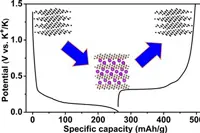 Research at Oregon State University has shown that potassium can work with graphite in a potassium-ion battery; a discovery which may pose a challenge and sustainable alternative to the lithium ion battery.
Research at Oregon State University has shown that potassium can work with graphite in a potassium-ion battery; a discovery which may pose a challenge and sustainable alternative to the lithium ion battery.
According to the research team, potassium ion batteries were last explored in 1932. “For decades, people have assumed that potassium couldn’t work with graphite or other bulk carbon anodes in a battery,” said Xiulei Ji, assistant professor of chemistry. “That assumption is incorrect. It’s really shocking that no one ever reported on this issue for 83 years.”
The findings are of considerable importance, the researchers say, because of lithium’s relative rarity – found in only 0.0017%, by weight, of the Earth’s crust. However, researchers have yet to duplicate its performance with less costly and more readily available materials.
The Oregon team’s work shows that that potassium – 880 times more abundant than lithium – can work effectively with graphite or soft carbon in the anode of an electrochemical battery. While the performance is not equivalent to that of lithium-ion batteries, improvements in technology should narrow the gap, said Ji.
“It’s safe to say that the energy density of a potassium-ion battery may never exceed that of lithium-ion batteries,” he said. “But they may provide a long cycling life, a high power density, lower cost and be ready to take advantage of the existing manufacturing processes of carbon anode materials.”
Author
Graham Pitcher
Source: www.newelectronics.co.uk

